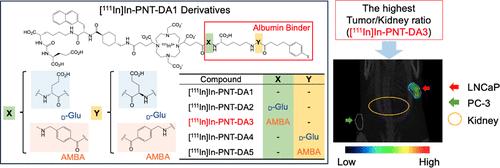Effect of Linker Entities on Pharmacokinetics of 111In-Labeled Prostate-Specific Membrane Antigen-Targeting Ligands with an Albumin Binder
引用次数: 0
Abstract
In the field of radiopharmaceutical development targeting cancer, an albumin binder (ALB) is commonly used to improve accumulation of radioligands in tumors because it has high binding affinity for albumin and extends the circulation time of radioligands. The further development of ALB-containing radioligands is also expected to regulate their pharmacokinetics. In this study, we newly designed and synthesized [111In]In-PNT-DA1 derivatives, prostate-specific membrane antigen (PSMA)-targeting radioligands including a functional linker (d-glutamic acid or 4-(aminomethyl)benzoic acid), and evaluated the relationships among the structure, albumin-binding affinity, and pharmacokinetics. These derivatives showed a different binding affinity for albumin by the introduction of a linker. Biodistribution studies revealed that the introduction of a linker affects the pharmacokinetics of each derivative. The biodistribution studies also suggested that moderate albumin-binding affinity enhances the tumor/kidney ratio of the derivative. SPECT imaging using [111In]In-PNT-DA3 with the highest tumor/kidney ratio among [111In]In-PNT-DA1 derivatives led to clear visualization of a PSMA-positive LNCaP tumor. The results suggest that the appropriate introduction of linker entities may be necessary to improve the pharmacokinetics of PSMA-targeting radioligands.

连接体实体对带有白蛋白粘合剂的 111In 标记前列腺特异性膜抗原靶向配体药代动力学的影响
在以癌症为靶点的放射性药物开发领域,白蛋白粘合剂(ALB)通常用于改善放射性配体在肿瘤中的蓄积,因为它与白蛋白的结合亲和力高,可延长放射性配体的循环时间。含 ALB 的放射性配体的进一步发展也有望调节其药代动力学。在这项研究中,我们新设计并合成了[111In]In-PNT-DA1衍生物--前列腺特异性膜抗原(PSMA)靶向放射性配体,包括一个功能连接体(d-谷氨酸或 4-(氨基甲基)苯甲酸),并评估了其结构、白蛋白结合亲和力和药代动力学之间的关系。通过引入连接体,这些衍生物显示出与白蛋白不同的结合亲和力。生物分布研究表明,引入连接体会影响每种衍生物的药代动力学。生物分布研究还表明,适度的白蛋白结合亲和力会提高衍生物的肿瘤/肾脏比率。在[111In]In-PNT-DA1衍生物中,[111In]In-PNT-DA3的肿瘤/肾脏比率最高,使用[111In]In-PNT-DA3进行SPECT成像可清晰显示PSMA阳性的LNCaP肿瘤。结果表明,要改善 PSMA 靶向放射性配体的药代动力学,可能需要适当引入连接体实体。
本文章由计算机程序翻译,如有差异,请以英文原文为准。
求助全文
约1分钟内获得全文
求助全文

 求助内容:
求助内容: 应助结果提醒方式:
应助结果提醒方式:


